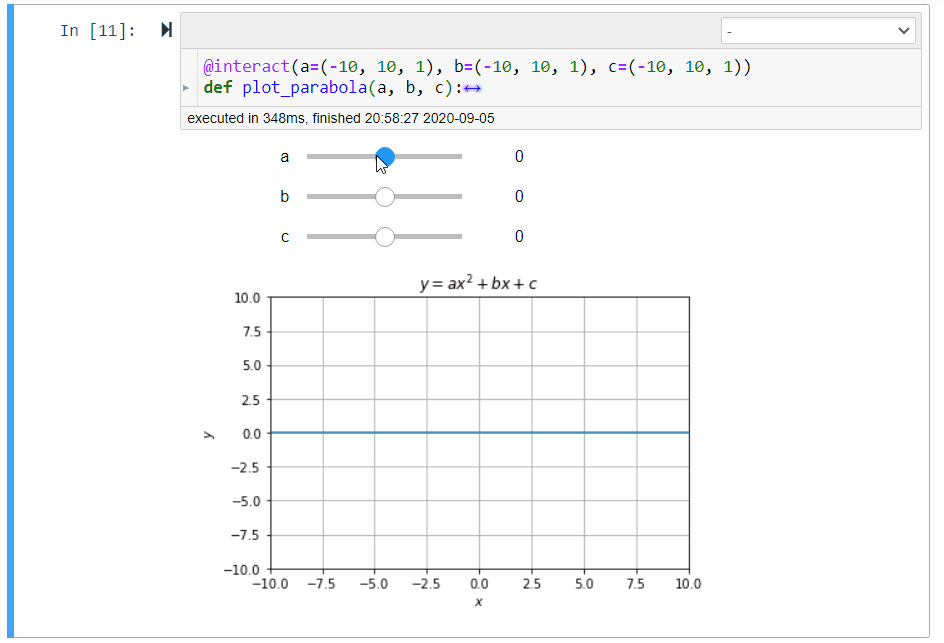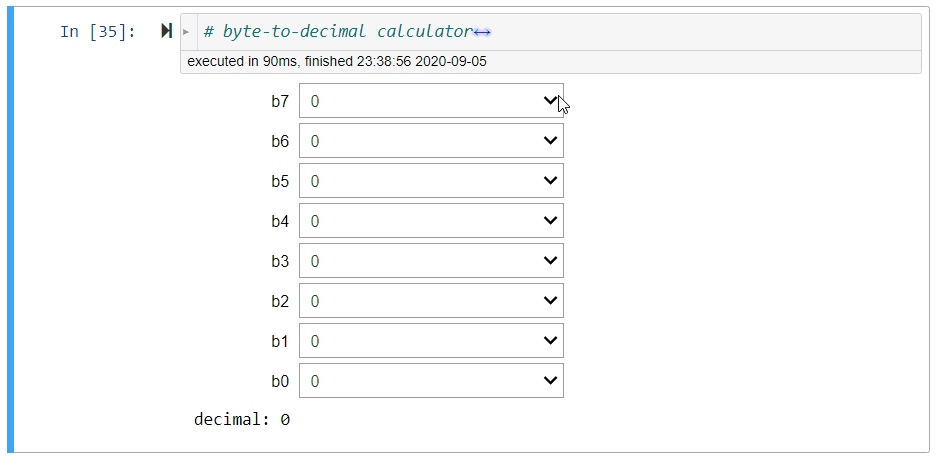3. Calculators¶
Run the following to load additional tools required for this lab.
In particular, the math library provides many useful mathematical functions and constants.
%reset -f
from ipywidgets import interact
import matplotlib.pyplot as plt
import numpy as np
import math
from math import log, exp, sin, cos, tan, pi
The following code is a Python one-liner that creates a calculator.
Evaluate the cell with Ctrl+Enter:
print(eval(input()))
Try some calculations below using this calculator:
\(2^3\) by entering
2**3;\(\frac23\) by entering
2/3;\(\left\lceil\frac32\right\rceil\) by entering
3//2;\(3\mod 2\) by entering
3%2;\(\sqrt{2}\) by entering
2**0.5; and\(\sin(\pi/6)\) by entering
sin(pi/6);
For this lab, you will create more powerful and dedicated calculators.
We will first show you a demo. Then, it will be your turn to create the calculators.
3.1. Hypotenuse Calculator (Demo)¶

Using the Pythagoras theorem below, we can define the following function length_of_hypotenus to calculate the length c of the hypotenuse given the lengths a and b of the other sides of a right-angled triangle:
$\(c = \sqrt{a^2 + b^2}\)$
def length_of_hypotenuse(a, b):
c = (a**2 + b**2)**(0.5) # Pythagoras
return c
You need not understand how a function is defined, but
you should know how to write the formula as a Python expression, and
assign to the variable
cthe value of the expression (Line 2).
For example, you may be asked to write Line 2, while Line 1 and 3 are given to you:
Exercise Complete the function below to return the length c of the hypotenuse given the lengths a and b.
def length_of_hypotenuse(a, b):
# YOUR CODE HERE
raise NotImplementedError()
return c
Note that indentation affects the execution of Python code. The assignment statement must be indented to indicate that it is part of the body of the function.
(Try removing the indentation and see what happens.)
We will use widgets (ipywidgets) to let user interact with the calculator more easily:
# hypotenuse calculator
@interact(a=(0, 10, 1), b=(0, 10, 1))
def calculate_hypotenuse(a=3, b=4):
print('c: {:.2f}'.format(length_of_hypotenuse(a, b)))
After running the above cell, you can move the sliders to change the values of a and b. The value of c will be updated immediately.
For this lab, you need not know how write widgets, but
you should know how to format a floating point number (Line 3).
You can check your code with a few cases listed in the test cell below.
# tests
def test_length_of_hypotenuse(a, b, c):
c_ = length_of_hypotenuse(a, b)
correct = math.isclose(c, c_)
if not correct:
print(f'For a={a} and b={b}, c should be {c}, not {c_}.')
assert correct
test_length_of_hypotenuse(3, 4, 5)
test_length_of_hypotenuse(0, 0, 0)
test_length_of_hypotenuse(4, 7, 8.06225774829855)
3.2. Quadratic Equation¶
3.2.1. Graphical Calculator for Parabola¶

In mathematics, the collection of points \((x,y)\) satisfying the following equation forms a parabola:
where \(a\), \(b\), and \(c\) are real numbers called the coefficients.
Exercise Given the variables x, a, b, and c store the \(x\)-coordinate and the coefficients \(a\), \(b\), and \(c\) respectively, assign to y the corresponding \(y\)-coordinate for the parabola.
def get_y(x, a, b, c):
# YOUR CODE HERE
raise NotImplementedError()
return y
# tests
def test_get_y(y,x,a,b,c):
y_ = get_y(x,a,b,c)
correct = math.isclose(y,y_)
if not correct:
print(f'With (x, a, b, c)={x,a,b,c}, y should be {y} not {y_}.')
assert correct
test_get_y(0,0,0,0,0)
test_get_y(1,0,1,2,1)
test_get_y(2,0,2,1,2)
# graphical calculator for parabola
@interact(a=(-10, 10, 1), b=(-10, 10, 1), c=(-10, 10, 1))
def plot_parabola(a, b, c):
xmin, xmax, ymin, ymax, resolution = -10, 10, -10, 10, 50
ax = plt.gca()
ax.set_title(r'$y=ax^2+bx+c$')
ax.set_xlabel(r'$x$')
ax.set_ylabel(r'$y$')
ax.set_xlim([xmin, xmax])
ax.set_ylim([ymin, ymax])
ax.grid()
x = np.linspace(xmin, xmax, resolution)
ax.plot(x, get_y(x, a, b, c))
3.2.2. Quadratic Equation Solver¶

For the quadratic equation
the roots (solutions for \(x\)) are give by
Exercise Assign to root1 and root2 the values of the first and second roots above respectively.
def get_roots(a, b, c):
# YOUR CODE HERE
raise NotImplementedError()
return root1, root2
# tests
def test_get_roots(roots, a, b, c):
roots_ = get_roots(a, b, c)
correct = all([math.isclose(roots[i], roots_[i]) for i in range(2)])
if not correct:
print(f'With (a, b, c)={a,b,c}, roots should be {roots} not {roots_}.')
assert correct
test_get_roots((-1.0, 0.0), 1, 1, 0)
test_get_roots((-1.0, -1.0), 1, 2, 1)
test_get_roots((-2.0, -1.0), 1, 3, 2)
# quadratic equations solver
@interact(a=(-10,10,1),b=(-10,10,1),c=(-10,10,1))
def quadratic_equation_solver(a=1,b=2,c=1):
print('Roots: {}, {}'.format(*get_roots(a,b,c)))
3.3. Number Conversion¶
3.3.1. Byte-to-Decimal Calculator¶

Denote a binary number stored as a byte (\(8\)-bit) as
where \(\circ\) concatenates \(b_i\)’s together into a binary string.
The binary string can be converted to a decimal number by the formula
E.g., the binary string '11111111' is the largest integer represented by a byte:
Exercise Assign to decimal the integer value represented by a byte.
The byte is a sequence of bits assigned to the variables b7,b6,b5,b4,b3,b2,b1,b0 as characters, either '0' or '1'.
def byte_to_decimal(b7, b6, b5, b4, b3, b2, b1, b0):
# YOUR CODE HERE
raise NotImplementedError()
return decimal
# tests
def test_byte_to_decimal(decimal, b7, b6, b5, b4, b3, b2, b1, b0):
decimal_ = byte_to_decimal(b7, b6, b5, b4, b3, b2, b1, b0)
correct = decimal == decimal_ and isinstance(decimal_, int)
if not correct:
print(
f'{b7}{b6}{b5}{b4}{b3}{b2}{b1}{b0} should give {decimal} not {decimal_}.'
)
assert correct
test_byte_to_decimal(38, '0', '0', '1', '0', '0', '1', '1', '0')
test_byte_to_decimal(20, '0', '0', '0', '1', '0', '1', '0', '0')
test_byte_to_decimal(22, '0', '0', '0', '1', '0', '1', '1', '0')
# byte-to-decimal calculator
bit = ['0', '1']
@interact(b7=bit, b6=bit, b5=bit, b4=bit, b3=bit, b2=bit, b1=bit, b0=bit)
def convert_byte_to_decimal(b7, b6, b5, b4, b3, b2, b1, b0):
print('decimal:', byte_to_decimal(b7, b6, b5, b4, b3, b2, b1, b0))
3.3.2. Decimal-to-Byte Calculator¶

Exercise Assign to byte a string of 8 bits that represents the value of decimal, a non-negative decimal integer from \(0\) to \(2^8-1=255\).
Hint: Use // and %.
def decimal_to_byte(decimal):
# YOUR CODE HERE
raise NotImplementedError()
return byte
# tests
def test_decimal_to_byte(byte,decimal):
byte_ = decimal_to_byte(decimal)
correct = byte == byte_ and isinstance(byte, str) and len(byte) == 8
if not correct:
print(
f'{decimal} should be represented as the byte {byte}, not {byte_}.'
)
assert correct
test_decimal_to_byte('01100111', 103)
test_decimal_to_byte('00000011', 3)
test_decimal_to_byte('00011100', 28)
# decimal-to-byte calculator
@interact(decimal=(0,255,1))
def convert_decimal_to_byte(decimal=0):
print('byte:', decimal_to_byte(decimal))